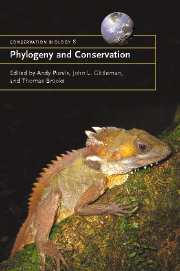Book contents
- Frontmatter
- Contents
- List of contributors
- 1 Phylogeny and conservation
- Part 1 Units and currencies
- 2 Molecular phylogenetics for conservation biology
- 3 Species: demarcation and diversity
- 4 Phylogenetic units and currencies above and below the species level
- 5 Integrating phylogenetic diversity in the selection of priority areas for conservation: does it make a difference?
- 6 Evolutionary heritage as a metric for conservation
- Part 2 Inferring evolutionary processes
- Part 3 Effects of human processes
- Part 4 Prognosis
- Index
2 - Molecular phylogenetics for conservation biology
Published online by Cambridge University Press: 04 December 2009
- Frontmatter
- Contents
- List of contributors
- 1 Phylogeny and conservation
- Part 1 Units and currencies
- 2 Molecular phylogenetics for conservation biology
- 3 Species: demarcation and diversity
- 4 Phylogenetic units and currencies above and below the species level
- 5 Integrating phylogenetic diversity in the selection of priority areas for conservation: does it make a difference?
- 6 Evolutionary heritage as a metric for conservation
- Part 2 Inferring evolutionary processes
- Part 3 Effects of human processes
- Part 4 Prognosis
- Index
Summary
Phylogeny reconstruction has been historically used as a tool in systematics and taxonomy, examining relationships among species and at higher level taxonomic classifications. However, with recent advances in our ability to collect nucleotide sequence data from a wide variety of organisms, coupled with advances in phylogenetic methodology and their comparative testing, there has been a broader application of phylogeny reconstruction into areas such as describing biodiversity to assign regional conservation priorities (Crozier 1992; Faith 1992), defining critical habitat areas (see, for example, Crandall 1998), and for understanding genetic patterns and processes at or below the species level (see, for example, Fetzner & Crandall 2003; Morando et al. 2003). There is also an increasing awareness among those involved in the development of conservation programmes that molecular data can be usefully combined for integrated conservation planning from the broader landscape or community level, to biogeographic subregions, and to individual species (Moritz 2002).
In cases where morphology is unable to resolve relationships among closely related taxa or particularly at the population level (intraspecific relationships), molecular approaches provide the much-needed resolution to interpret evolutionary histories. Defining species still remains an extremely contentious issue among scientists; however, criteria may be defined to test (morphologically cryptic) species boundaries, phylogenies may be statistically tested according to these criteria (see below), and outcomes compared between different phylogenetic reconstruction methods or different data sets (e.g. morphology versus molecular, different gene regions).
- Type
- Chapter
- Information
- Phylogeny and Conservation , pp. 19 - 56Publisher: Cambridge University PressPrint publication year: 2005
- 10
- Cited by



